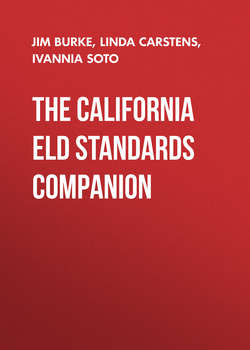Читать книгу The California ELD Standards Companion, Grades 3-5 - Jim Burke - Страница 12
На сайте Литреса книга снята с продажи.
Part 1 Interacting in Meaningful Ways A Collaborative Mode Introduction
ОглавлениеPart I of the California ELD Standards promotes English Language Learners’ abilities to interact in meaningful ways so that they acquire English and develop content knowledge simultaneously. Part I comes first in the standards to emphasize that students need to interact with adults and each other about meaning and content in order to build background knowledge and provide context before they enter deeply into how the English language works. Part I, Interacting in Meaningful Ways, is subdivided into three clusters of standards that emphasize student participation in the major modes of communication: Collaborative, Interpretive, and Productive.
Cluster A: Collaborative Mode Standards have the same general descriptions across Grades K–12 for the four standards in the cluster, related to engagement in dialogue with others. These include
1 Exchanging information and ideas with others through oral collaborative conversations on a range of social and academic topics. Teachers can structure collaborative learning practices for small-group discussion about the texts students read across subject areas. These practices help students learn the content, vocabulary, and grammatical structures related to the texts in language-rich, iterative social situations. While this standard can be applied to conversations around academic texts, it can also be applied to any type of conversation (social or academic) or to conversations that arise during collaborative group work (Heller & Greenleaf, 2007; Vaughn et al., 2011).
2 Interacting with others in written English in various communicative forms (print, communicative technology, and multimedia). This standard is specific to collaborating through written English (e.g., passing notes, written feedback, collaborative group writing/multimedia projects, collaboration using technology) but also includes word-level processing, such as decoding and spelling. It also includes recognizing the organizational features of different academic texts so that students can better comprehend and create their own written texts (Brisk 2012; Gibbons, 2008; Hammond, 2006).
3 Offering and supporting opinions and negotiating with others in communicative exchanges. Not all students come to school knowing how to engage in collaborative discussions with others. Recent research has shown that ELLs can learn how to do this by being “apprenticed” through scaffolded interactions in classroom discussion settings (Gibbons, 2009; Walqui & van Lier, 2010).
4 Adapting language choices to various contexts (based on task, purpose, audience, and text type). Choosing the right language depends on what is happening (the content), who is communicating and their relationship (e.g., peer to peer, student to adult), how the message is conveyed (e.g., written, spoken), and whether the communication is formal or informal (Schleppegrell, 2012). Student success with adapting language choices grows with student ability to increase vocabulary, recognize and use appropriate register, use more complex sentence and clauses, and use connecting/transitioning words to convey meaning (O’Dowd, 2010; Schleppegrell, 2004).
In The California ELD Companion, the section on What the Student Does provides specific descriptions of competence with each of the Collaborative standards at the appropriate grade range and proficiency level. Similarly, the section on What the Teacher Does provides specific strategies for developing competence with each of the Collaborative standards at the appropriate grade range. And the last section, Vignettes and Snapshots, offers classroom level descriptions of what each standard looks like in practice.
Source: California English Language Development Standards, K–12 (2012). Chapter 4, “Theoretical Foundations and the Research Bases of the CA ELD Standards,” provides an excellent summary of the research used in developing the four Collaborative standards in Part I, A.
